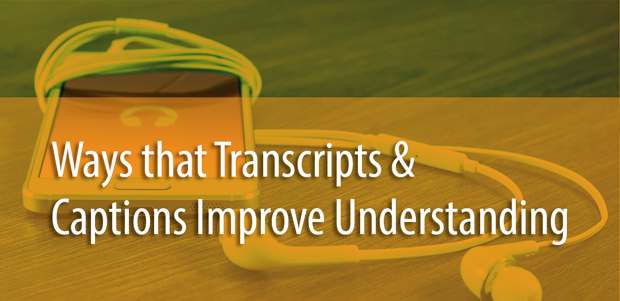So, even if you’re not hard of hearing, captions and transcripts can improve your understanding of a video if it has low sound quality, or if the subject mumbles, or is otherwise hard to understand. But aren’t those just symptoms of poor video making? Shouldn’t you work to make sure that your video IS easy to understand for the average person?
Perhaps, but there are plenty of other circumstances wherein a person might have trouble understanding your video, that have nothing to do with how it’s made. Let’s take a look at a few of these circumstances, and see why captions and transcripts are a good idea in any situation.
- Captions and Transcripts in Noise-Challenged Conditions. The rise of mobile devices means that now, people can watch videos anywhere, at any time. Which further means that they may well be watching your video in conditions that are less than ideal for audio playback. Someone might bring out their smartphone at a party and show your video to a few of their friends. Or they might watch it to kill time on the bus, or at the DMV. We can’t control the noise levels of the world around us, but that doesn’t stop us from trying to bring our entertainment into those environments. If someone is trying to watch your video and can’t hear it, the best-case scenario is that they’ll miss most of it and not really understand what it was about. The worst-case scenario is that they’ll give up halfway through. Maybe they’ll remember to come back to it later, when there’s less noise around—or maybe they won’t. However, if you’ve got captions on your video, they can understand it much more clearly, under any circumstances.
- Captions and Transcripts in Public Situations. Turning on the captions and transcripts not only helps when the outside world is encroaching on their video, it can also keep their video from encroaching on the outside world. If a viewer is on the bus or at the DMV—or at work, or anywhere else with other people around—playing a video so that everyone nearby is forced to listen to it as well is rude. Even if the viewer is in their own home, a video’s volume may be disturbing to their spouse trying to read in bed next to them, or their children doing homework in the next room. Captions allow them to turn the volume down to a reasonable level that won’t disturb those around them, while still getting every word of the video they’re watching.
- Captions and Transcripts in Difficult Audio Situations. Of course, you should always make an effort to have the best possible audio for each of your videos. However, there are times when this isn’t feasible. If you’re filming an interview or documentary, there may be external conditions beyond your control, such as background noise or heavy wind. Or your interview subject may speak with a heavy accent and be difficult to understand. In cases such as this, captions and transcripts are important for helping your viewers to understand what’s being said in your video.
- Transcripts and Captions for Viewers Speaking Another Language. There are two aspects to this type of understanding. The most obvious is subtitles. If you’re trying to reach a global audience with your video content, then in addition to English captions, you should also include a choice of subtitles, for whatever additional markets you’re trying to reach. These can also be done by professional captioning and transcript services, and are a great way to help people who don’t speak English to understand your video. But what about the people in your audience who do speak English, but not as their first language? It’s not uncommon for these people to turn on the English captions for a video, in order to help them follow along better. Providing that for them will help them engage better with your video, and with your brand as a whole.
- Transcripts and Captions for the Hearing Impaired. While we’ve shown why this isn’t the main reason to include transcripts and captions on your videos, it is still an important factor that can’t be overlooked. If you don’t caption your videos, then you’re ignoring the deaf community and making it more difficult for them to engage with your brand. Not only is this inconsiderate, it’s also bad business. If you can reach the deaf community with your brand by including transcripts and captions, then why wouldn’t you?
- Transcripts for Student Learning Experience. A 2012 Massachusetts Institute of Technology (MIT) OpenCourseWare study showed that adding interactive transcripts to their online video lectures significantly impacted their learning experience. 97% of the students who voluntarily filled out the survey indicated that “interactive transcripts improved their learning experiences.”
In addition to these basic reasons, different people have their own challenges to understanding the videos they watch, and likewise have different reasons for using captions and transcripts in their viewing. Whatever the reason, it’s important to provide those captions and transcripts for anyone who wants them, so that they can enjoy and understand your content in a way that’s comfortable for them.
